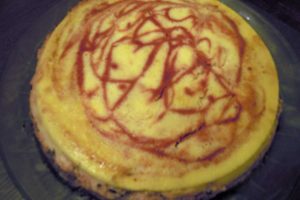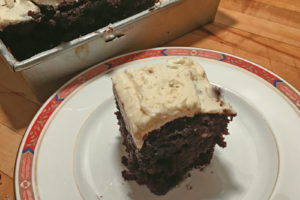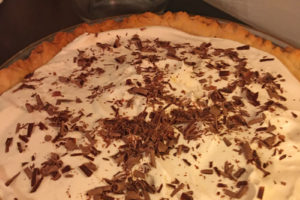Buttermilk Peanut Rolls were one of the special treats of my childhood. Rockford, Illinois, had a a plethora of great bakeries—mostly Swedish, but one wonderful Polish bakery called Labunsky’s. It was a drab place housed in an old garage, back from the street in an alleyway. Their two specialties were “snowballs,” a cream-filled powdered-sugared doughnut and the peanut rolls.
My parents would freeze them both, pack them in dry ice and bring them to New York for me until they were no longer able to travel. Labunsky’s closed in the 1970s, along with the even more wonderful Swedish bakeries—all done-in by the blandly generic, ubiquitous, and unspeakable supermarket bakeries. When Labunsky’s closed, I wrote to the former owners begging for the recipes for these two confections. My pleas were sadly never answered. This recipe is my attempt to create the peanut rolls, a pastry I’ve never seen for sale elsewhere.
I’m certain my recipe bears little resemblance to Labunsky’s version. I doubt very much that they used buttermilk, which I chose to give the roll a more tender crumb. However, I found the end result a nearly identical substitute. It captures the unusual but pleasing amalgam of peanuts and cinnamon.
For the Dough
Make certain that the buttermilk, eggs, and butter are all at room temperature before you begin. Dissolve the yeast in warm water, stirring in a tablespoon of sugar. Allow it to stand for 10 minutes.
In the bowl of a stand mixer and using a whisk, beat together the yeast mixture and the eggs.

Eggs and yeast mixture.
Then beat in a a couple tablespoons of flour and, the softened butter.

Adding butter.
Finally, beat in the remaining 4 tablespoons of sugar, the baking powder, salt, and a little more flour.

Adding dry ingredients.
Place the bowl on the mixer stand. Using a dough hook, on low speed add 1/2 cup of flour at a time until you get an elastic dough that can be kneaded.

Incorporating the flour.
Remove the dough from the bowl and knead on a lightly floured surface until the dough and smooth and very elastic.

The kneaded dough.
Butter a large bowl and roll the dough in the bowl to coat with butter. Cover with plastic wrap and refrigerate for several hours or overnight. I like to do this overnight to break the job up into more manageable segments.
Remove the dough from the refrigerator, and let it rise until doubled in bulk.
Assembly
On a lightly floured board, roll out the dough in a 24×10-inch rectangle, about 1/4-inch thick.

Rolled out dough.
Cut the dough in half with a sharp knife.

Cut into 2 equal pieces.
Whisk together the sugar and cinnamon. Spread soft butter over each piece of dough, leaving a one-inch border on the farthest end. Sprinkle the cinnamon and sugar mixture over the buttered areas, and spread chopped unsalted peanuts over the surface.

Spreading the filling.
Moisten the clean edge with water. Beginning at the long edge nearest you, roll the dough into a tight log, patting the ends to keep them even. Pinch together the seam to seal the logs and roll them so the seam side is down.

Rolling the dough into logs.
Cut the logs with a very sharp knife or a piece of dental floss into 1 1/2-inch lengths. Fit the pieces into two buttered 9-inch cake pans.

Filling cake pan with slices.
Cover the pans loosely with plastic wrap and let them rise until doubled—about an hour and ten minutes.
Baking
Place one rack on the bottom and another in the middle of the oven. Preheat the oven to 350 degrees. Bake the rolls on the bottom rack for about 15 minutes. Move them to the middle rack, rotating the pans. Bake another 15-20 minutes until the tops are golden and the rolls sound hollow when tapped.

Baked rolls.
Remove from the oven and cool on a rack.
Icing
Beat together the butter and vegetable shortening. Gradually sift in the confectioner’s sugar, then beat in vanilla and enough heavy cream to give the icing a good texture.
When the rolls have completely cooled, spread the icing over the rolls and sprinkle with more chopped peanuts, pressing them gently into the icing.

Iced rolls.
Cut and pull the rolls apart to serve.

Serving the rolls.
Tips
This recipe makes a large quantity. You can take one of the unbaked cake pans, cover, it and freeze it. When you wish to bake it, you can remove it from the freezer and give it several hours to double in size. Then bake as usual.
Although I am loath to use vegetable shortening in the icing, I find it gives it a bit more substance and prevents the icing from melting so much, especially in warm weather. It should be a real icing, not a glaze. Use all butter if you plan to eat them all in one sitting.
I also experimented with baking them individually in a buttered popover or muffin pan. This gives a rather attractive effect. The only problem is that the sides develop a crust. If the lack of soft-sided roll doesn’t bother you, this gives you another alternative.

Roll baked in popover pan.




